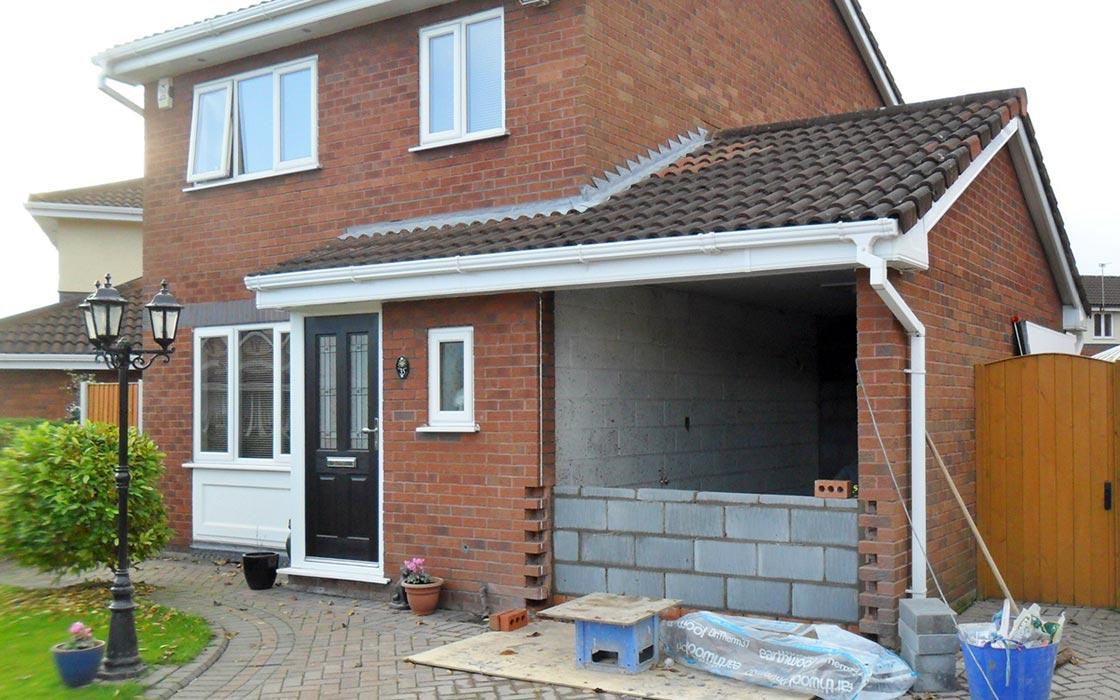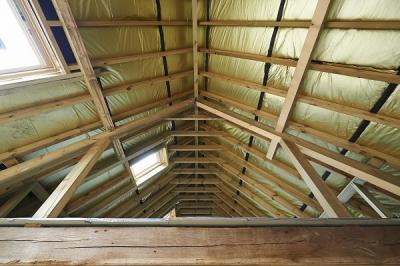Garage conversion: Tips from our building control experts
A garage conversion doesn't always need planning permission as it often falls under 'permitted development'. But it's important to check permitted development rights still apply before starting any work, even if just for your client's sake.
Converting a garage will always need a building regulations application. A Building Notice application where detailed plans aren't needed will usually do, although a Full Plans application with a fully detailed specification will give you and your customer more security about what work needs to be carried out before you commence on site.
7 key considerations for a good garage conversion job
You must ensure the foundations are strong enough to carry any additional masonry loads. A new inner skin on the external wall or filling in the garage door with brick & block and a window will all add extra weight. Check the condition and suitability of the existing foundation or floor when the door infill area is excavated. If there isn't a foundation below the existing garage door you could carry the new wall off a suitable lintel - talk to your building control surveyor.
1. Walls
Check the existing walls for stability and make sure there aren't any defects. If satisfactory, then your building control surveyor is likely to consider it suitable for structural purposes. If it's single skin with piers and the piers are being removed, the wall will be weakened and should be tied to a new inner leaf using remedial wall ties.
2. Weather
If you're dealing with a wall of single leaf construction, you must treat it to make it weatherproof. Treatment options include tanking the wall using a vapour permeable membrane linked to a damp proof course or membrane at floor level or providing a lightweight blockwork inner leaf with insulation in the new cavity. In all wall types, care must be taken to ensure the floor membrane laps with the DPC in the existing walls.
3. Insulation
You must insulate the walls, roof, floor and any new windows, rooflights and doors to habitable standards, your designer will help you choose the right insulation, but the level of insulation should provide U-Values equal to or better than:
- Roof 0.15 W/m2K
- External walls 0.18 W/m2K
- Floor 0.18 W/m2K
- Windows 1.4 W/m2K (Band B) [1.6 W/m2K (Band C) for timber frame windows until 14 June 2023]
- Doors 1.4 W/m2K (Band B) [1.8 W/m2K (Band E) for timber fire doors and, until 14 June 2023, other external timber doors]
- Rooflights 2.2 W/m2K
Remember that you may need to add or increase ventilation to roof voids. When lining the garage with an independent stud partition, the insulation should be fitted tightly between the studs - using insulated plasterboard is best to avoid cold bridging. The maximum area of glazing/openings should not exceed 25% of the floor area of the space being converted. Other options for design flexibility might be available and you should discuss these with your designer. These fabric values might change again after 2025.
4. Ventilation
Windows must have openable vents of an area equal to either 1/10th of the floor area of the room (for windows having a fully open angle of between 15degrees to 30degrees), or 1/20th of the floor area (for all other window openings/angles of more than 30degrees). If the conversion is for a new habitable room or kitchen to either a bungalow, or a house with multiple floors, the room must also have either 10,000mm2 or 8,000mm2 of trickle (background) ventilation, respectively – which might be a vent contained in the window frame. If the conversion is for a new wet-room (a kitchen/bath/shower/toilet/utility room) then there should be background ventilation of at least 5,000mm2 and an extractor fan should be provided to extract air at a rate of:
- 30l/s Kitchen with cooker hood extracting directly to outside
- 60l/s Kitchen without a cooker hood or with only a recirculation hood
- 30l/s Utility room
- 15l/s Bath and/or Shower-room
- 6l/s Toilet
If the conversion is to create a lounge, dining/TV/play room or sleeping space or similar and the room can only be accessed through another room, a window with a clear opening of 450 x 733mm at no more than 1.1m above floor level is a must for means of escape (it’s also a good idea to install a domestic smoke alarm to cover the area outside the converted room, and installed either in any connecting circulation space or access room). It is also strongly recommended that any new windows or doors be designed to be secure against possible break-in.
5. Sound
Any party wall between the garage and an adjoining property will need to be insulated to stop sound transmission. Check the existing wall construction - anything less than 200mm of dense blockwork will usually need further work, which may include additional masonry or specialist independent acoustic partitions – your building control surveyor will be able to advise you further.
6. Electricity
The requirements of Part P - Electrical safety in dwellings will apply to the new conversion, so ensure any installations are compliant and certified to BS 7671.
Your building control surveyor should be able to provide practical guidance on site.
Find your local LABC team with our free postcode search tool
Did you find this article useful?
Further details on garage conversions can be found on the LABC Front Door website.
Then read our advice and watch videos on:
Image courtesy of woodspropertysolutions.co.uk
Please Note: Every care was taken to ensure the information was correct at the time of publication. Any written guidance provided does not replace the user’s professional judgement. It is the responsibility of the dutyholder or person carrying out the work to ensure compliance with relevant building regulations or applicable technical standards.
This article was updated on 18 July 2022
Sign up to the building bulletin newsletter
Over 48,000 construction professionals have already signed up for the LABC Building Bulletin.
Join them and receive useful tips, practical technical information and industry news by email once every 6 weeks.
Subscribe to the Building Bulletin




Comments
Fixed pane windows
Submitted 4 years 11 months ago
PD rights removed
Submitted 4 years 10 months ago
I’m 3 weeks from completion and asked the architect to start the ball rolling with getting it done as soon as I’m in. He’s come back that PD rights were removed on original planning application to maintain off street parking. Even though it has a large 4 car driveway.
What are the odds that I can still get planning permission even with PD rights removed.
Thanks in advance
Reply
Submitted 4 years 10 months ago
You'll need to contact your local planning authority who'll be able to advise.
Kind regards
Julie, LABC
Integral Garage
Submitted 4 years 10 months ago
We have an integral garage. We want to create a door access from within our house. The house is timber framed. The door will lock and be fire door. Do we need permissions?
Drainage in cavity
Submitted 3 years 11 months ago
What sort of drainage do I need to provide in the new cavity? Will concrete infill with a slope towards the exterior wall and weep holes be sufficient?
LABC response
Submitted 3 years 11 months ago
Thank you for your enquiry. The particular nature of your proposal would need to be discussed in more detail as there might be multiple options available and it is likely that a building regulations application will need to be made. In this situation we suggest you contact the Building Control team at your Local Authority to discuss any project specific requirements and to determine if an application is needed.
Best,
LABC team
Part E
Submitted 3 years 9 months ago
I cannot see how this type of conversion would be a change of use as it does not fall into any of the categories provided within regulation 5 meaning of material change of use?
I would assume it would be a material alteration and the relevant requirements within material alteration would apply which would not include Part E.
Thanks
Sam
LABC response
Submitted 3 years 9 months ago
Thank you for your enquiry. The conversion of an integral or attached garage to a habitable space is a conversion and as such LABC take the view that the work can be considered as building work. Regulation 2(1) confirms that building” means any permanent or temporary building but not any other kind of structure or erection, and a reference to a building includes a reference to part of a building. Therefore, we would read Regulation 5 (a) as applying in terms of the building/part is used as a dwelling where previously it was not by conversion from the use of a garage for storage of a vehicle to use as a habitable space.
We would also refer to Regulation 6 2) Where there is a material change of use of part only of a building, such work, if any, shall be carried out as is necessary to ensure that the part complies in all cases with any applicable requirements referred to in paragraph (1)(a). We also note your reference to a material alteration, and we are aware that many conversions use this route to be kicking off the requirement for compliance with the Building Regulations and when using this the building work (Reg 3(1)(c)) must be carried out in accordance with regulation 4(1) in respect of all the applicable requirements in schedule 1 of the regulations.
It would therefore be reasonable to apply Part E to a party wall between 2 houses, however from your e-mail you only outline that the garage is to be converted into a bedroom, therefore as LABC is unable to comment on specific projects , you would be advised to discuss the work with your LABC team.
Best,
LABC team
Garage conversion
Submitted 3 years 5 months ago
LABC Response
Submitted 3 years 4 months ago
Thank you for your enquiry.
“LABC does not provide a design service and the thickness of insulation and thermal performance of the floor will be dictated much by the length of the perimeter of the garage and the area of the floor (the P/A factor). Notes 4 and 5 in table 4.2 of approved Document L Volume 1, direct that –
4. If meeting such a standard would create significant problems in relation to adjoining floor levels, a lesser provision may be appropriate.
5. The U-value of the floor of an extension may be calculated using the exposed perimeter and floor area of the whole enlarged dwelling.
We recommend that you obtain advice from a qualified and competent construction professional such as a designer, architect, surveyor, energy assessor etc, who should be able to calculate the area to be insulated and consider the types of floor insulation systems available from the various insulation product manufacturers. We recommend that whilst table 4.2 suggests a U-Value of 0.18, consideration be given to better performing (lower) U-Values, given the likelihood that energy costs are predicted to increase. – spend now to save later.”
Kind Regards,
LABC Team
Add new comment